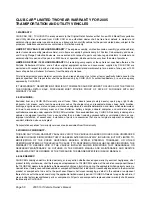
Battery Charger – Electric Vehicles
2005 Turf Vehicle Owner’s Manual
Page 35
BATTERY CHARGER – ELECTRIC VEHICLES
ý
DANGER
• The charging area must be ventilated. Hydrogen level in the air must never exceed 2%. The
total volume of air in the charging area must be changed five times per hour. Exhaust fans
should be located at the highest point of the roof. Contact a local HVAC engineer.
• Do not charge the vehicle batteries with the vehicle covered or enclosed. Any enclosure or
cover should be removed or unzipped and pulled back when batteries are being charged. An
accumulation of hydrogen gas could result in an explosion.
ý
WARNING
• Only trained technicians should repair or service the charger. Contact a Club Car distributor/
dealer.
• Each charger should have its own dedicated 15 or 20 ampere separately protected (circuit
breaker or fuse) single phase branch circuit, in accordance with all applicable electrical codes
for the location.
• Be sure wire connections at the receptacle and fuse link are clean and tight.
• Have worn, cut, or damaged power cords or wires replaced immediately.
• Do not expose to rain or any liquid. Keep the charger dry.
• Do not use near fuels, grain dust, solvents, thinners, or other flammables. Chargers can ignite
flammable materials and vapors.
• Connect the charger AC supply cord to a properly grounded, three-wire outlet of the proper
voltage and frequency as shown on the charger.
• Do not use an adapter to plug the charger with a three-prong plug into a two-prong outlet.
Improper connection of the equipment-grounding conductor can result in a fire or an
electrical shock.
• An extension cord or electrical outlet must accept a three-prong plug. Extension cord should
be a three-wire No. 12 AWG (American Wire Gauge) or No. 14 SWG (British Standard Wire
Gauge) and be as short as possible. The use of improper extension cord could result in fire or
an electrical shock.
• Do not operate the charger if it has received a sharp blow, was dropped, or otherwise
damaged in any way.
• Do not push objects of any kind into the charger through cabinet slots. They may touch
dangerous voltage points or cause an electrical short circuit that could result in fire or
electrical shock.
• Do not connect a stationary charger to the receptacle if the charger cord, plug, or the vehicle
receptacle is broken, damaged in any manner, or does not make a good electrical connection.
Fire or personal injury can result. Have a qualified technician repair or replace it immediately.
• When using a stationary charger, do not pull on the DC cord (Figure 26, Page 37). Do not twist,
rock, or bend the plug. To disconnect the plug from the receptacle, grasp the plug, not the
cord, and slowly pull it straight out of the receptacle (Figure 25, Page 37).
• When the charger is ON, the charger DC cord may be disconnected from the vehicle
receptacle slowly. Jerking or pulling the DC cord out quickly could cause arcing and burning
that could damage the plug and receptacle and could cause batteries to explode.
Summary of Contents for Turf 1 2005
Page 1: ...Owner s Manual 2005 Turf Vehicles Electric and Gasoline Turf 1 Turf 2 Turf 6...
Page 2: ......
Page 57: ...Vehicle Specifications Gasoline Vehicles Page 48 2005 Turf Vehicle Owner s Manual...
Page 65: ......
Page 66: ......
Page 67: ......






























